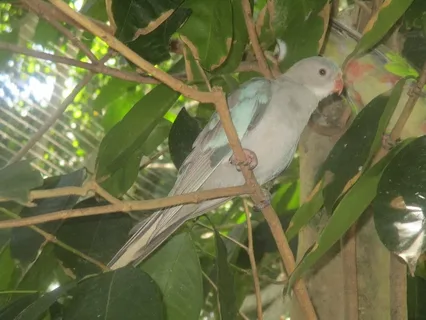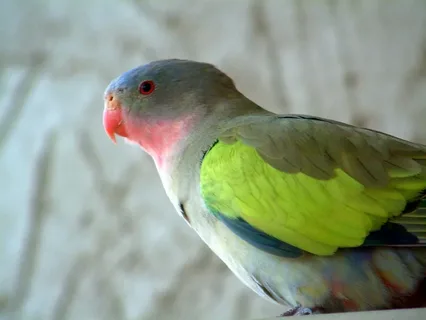The Princess Parrot is a beautiful, gentle, and intelligent bird species native to Australia. The Princess of Wales Parakeet, known for its pastel colors and quiet temperament, also goes by that name. Pet owners and bird watchers alike love this bird.
In this article, I will explore everything you need to know about the Princess Parrot, including its origin, scientific name, physical appearance, habitat, care tips, grooming needs, fun activities, and fascinating facts.
Origin of the Princess Parrot
The Princess Parrot is native to the dry, inland areas of central and western Australia. It is often found in arid forests, desert woodlands, and shrublands. These birds are naturally migratory, which means they travel in small flocks for food and water.
So this parrot was named in honor of Princess Alexandra of Denmark, who later became Queen of the United Kingdom. Because of its royal connection and graceful appearance, it is also known as the Princess of Wales Parakeet.
Species Name and Scientific Name
Common Name: Princess Parrot
Also Known As: Princess of Wales Parakeet, Queen Alexandra Parrot
Scientific Name: Polytelis alexandrae
This bird belongs to the genus Polytelis, a group of Australian parrots that are known for their long tails and elegant flight.
Classification of the Princess Parrot
Here is the scientific classification of the Princess Parrot:
- Kingdom: Animalia
- Phylum: Chordata
- Class: Aves
- Order: Psittaciformes
- Family: Psittaculidae
- Genus: Polytelis
- Species: Polytelis alexandrae
This classification places the Princess Parrot within the parrot family, closely related to other colorful species native to Australia.
Physical Appearance and Color of Princess Parrot
The Princess Parrot is known for its soft, pastel colors and elegant features. Its long, graceful tail and slim body make it one of the most attractive pet birds.
Key features include:
- Length: Around 45 cm (18 inches), including the tail
- Weight: Varies from 100 to 120 grams
- Body Color: Light green or olive green
- Breast and Face: Pale pink to salmon color
- Shoulders: Bright blue patches
- Tail: Long and bluish-purple
- Beak: Reddish in males, duller in females
- Eyes: Red-orange with a pale eye ring
The males tend to be brighter in color and have longer tail feathers compared to females.
Natural Habitat
In the wild, Princess Parrots live in dry, remote regions of central and western Australia. They prefer open forests, desert scrublands, and areas with scattered trees such as eucalypts and acacias.
They nest in hollow trees and are usually seen during the breeding season near water sources. Because of their migratory nature, they can be hard to spot in the wild.
Caring for a Princess Parrot
The Princess Parrot is easy to care for and adapts well to home environments. Regular attention and the right setup can make it a loving and low-maintenance pet.
Housing
- A large cage or aviary is needed to give the bird space to fly.
- Minimum cage size: 36 inches wide x 24 inches deep x 36 inches high
- Include natural wood perches, ladders, and toys for enrichment.
-
Place the cage in a well-lit area, away from drafts or direct sunlight.
Diet and Nutrition
A healthy Princess Parrot diet should include:
- High-quality parrot seed or pellet mix
- Fresh fruits like apples, pears, melons, and berries
- Vegetables such as spinach, broccoli, and carrots
- Occasional treats like millet spray or unsalted nuts
- Clean, fresh water daily
Avoid feeding chocolate, avocado, caffeine, or salty foods as they are toxic to birds.
Behavior
- Friendly and social
- Quiet and not overly noisy
- Can bond well with one person or the whole family
- Tolerates other birds if introduced properly
Each parrot species has its own unique set of behaviors and personality traits. So if you’re interested in learning more about different parrots, I’ve also written detailed articles on species like the Hyacinth Macaw and the Lineolated Parakeet.
Grooming and Cleaning
Keeping your Princess Parrot clean and well-groomed is important for its health.
Feather Care
Princess Parrots groom themselves regularly. However, you can help by:
- Offering light mist sprays for feather moisture
- Providing a shallow bath dish for the bird to bathe in
- Avoid trimming flight feathers unless necessary for safety
Nail and Beak Maintenance
- Natural perches and toys help wear down nails
- Cuttlebones and mineral blocks keep the beak trimmed
- Regular checks can prevent overgrowth
Cage Cleaning
- Change the bottom liner every 1–2 days
- Wash food and water dishes daily
- Clean perches, toys, and cage bars weekly
- Use a bird-safe disinfectant for deep cleaning
Fun Activities for Princess Parrots
The Princess Parrot enjoys mental and physical stimulation. Without it, they may become bored or frustrated.
Activities they enjoy include:
- Playing with chewable toys made of rope, wood, or leather
- Exploring puzzle feeders and foraging toys
- Climbing ladders and swinging on perches
- Training sessions with simple commands and treats
- Social time outside the cage in a safe area
Regular interaction helps build trust and strengthens the bond with your bird.
Interesting Facts About the Princess Parrot
Here are some amazing and lesser-known facts about the Princess Parrot:
- It was named after royalty, giving it a royal status among birds.
- Despite being native to Australia, it is rarely seen in the wild due to its nomadic lifestyle.
- Princess Parrots can live 25 to 30 years in captivity with proper care.
- They are one of the few relatively quiet parrots, making them ideal for apartments.
- Although not strong talkers, some individuals can learn to mimic a few words or sounds.
- Their gentle nature makes them suitable for first-time bird owners.
- They can form close bonds with their human companions and enjoy gentle handling.
Conclusion
The Princess Parrot is a stunning and peaceful bird that makes a wonderful pet for those who are willing to give it time, space, and attention. With its calm personality, beautiful colors, and low noise level, it is a great choice for families, singles, and even first-time bird owners.
By understanding its natural habits, offering a proper diet, maintaining a clean environment, and providing fun enrichment activities, your Princess Parrot can enjoy a happy and healthy life for many years.
Whether you’re considering adopting one or just want to learn more about this amazing species, the Princess Parrot is truly a gem among companion birds.
Most Commonly Asked Questions About Princess Parrot
-
Where are Princess Parrot from?
They are from the dry inland areas of Australia. -
What do they eat?
They eat seeds, fruits, flowers, and sometimes insects. -
Are Princess Parrots endangered?
No, they are not endangered but are considered rare in the wild. -
How long do Princess Parrots live?
They can live for 15 to 30 years with good care. -
Can Princess Parrots talk?
Yes, they can learn a few words and sounds. -
Does a Princess Parrot talk?
Yes, some Princess Parrots can talk, but not all of them do.

